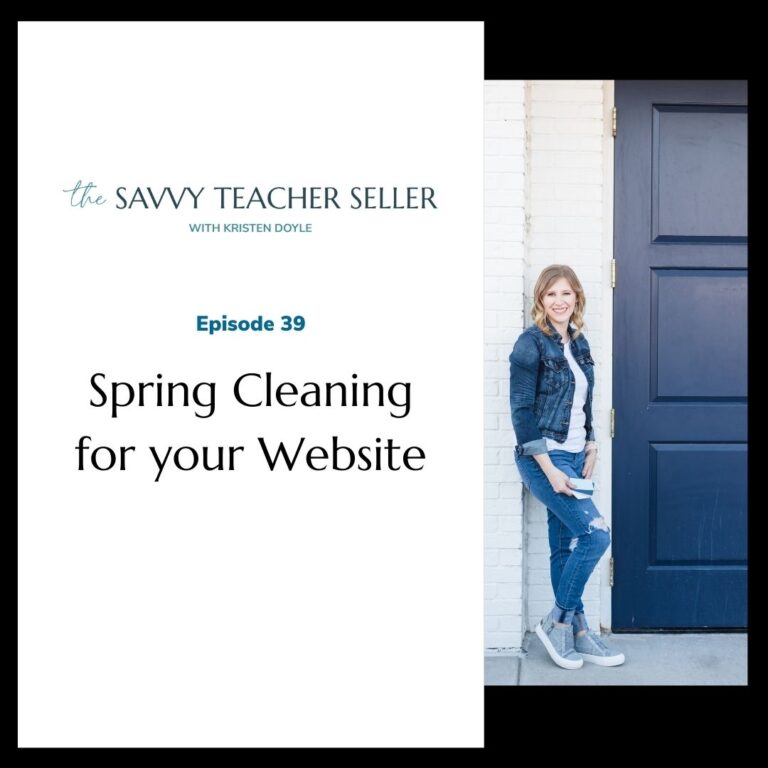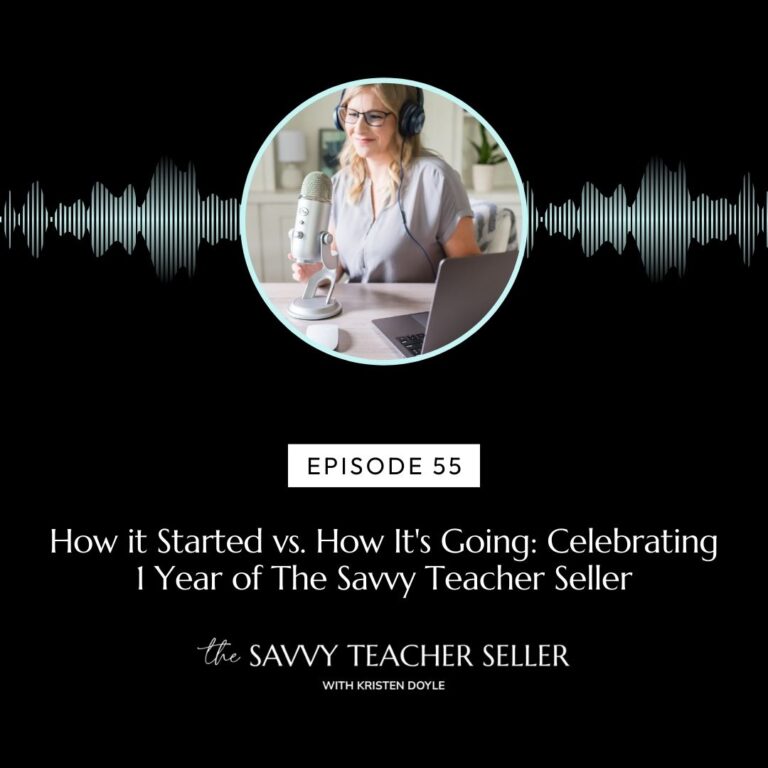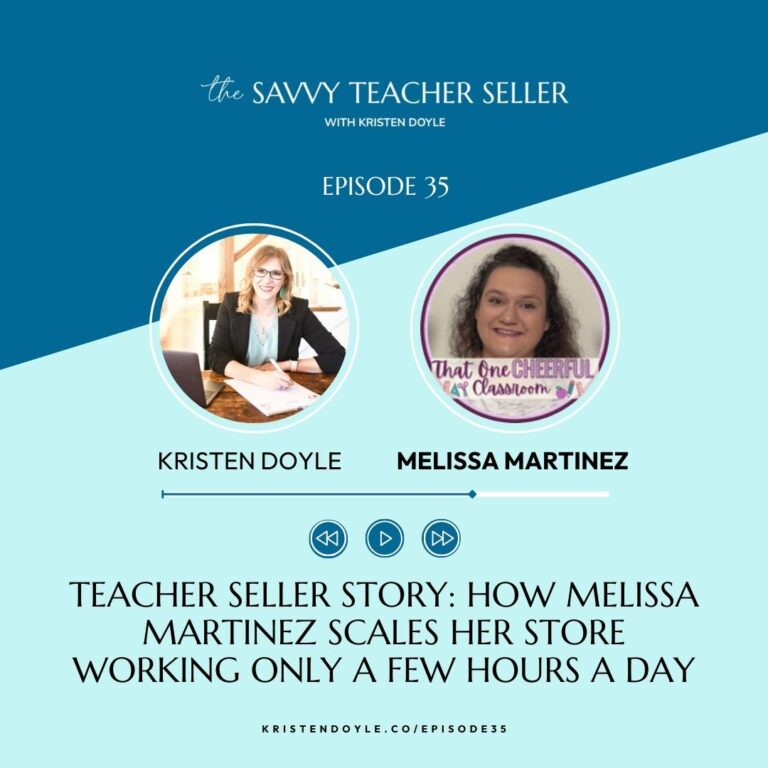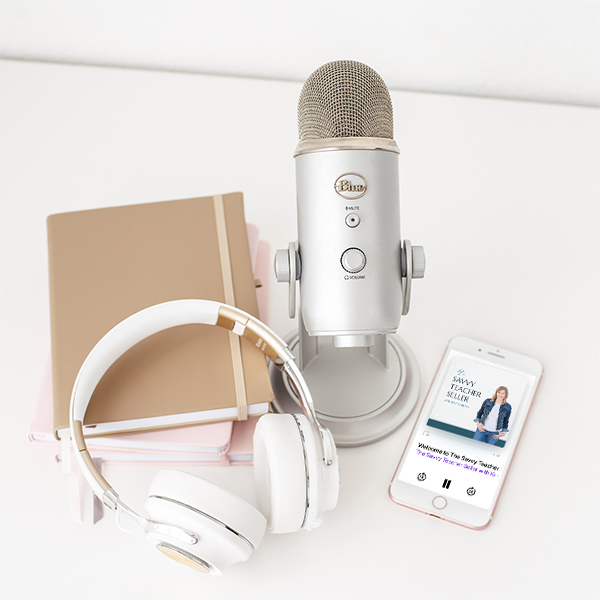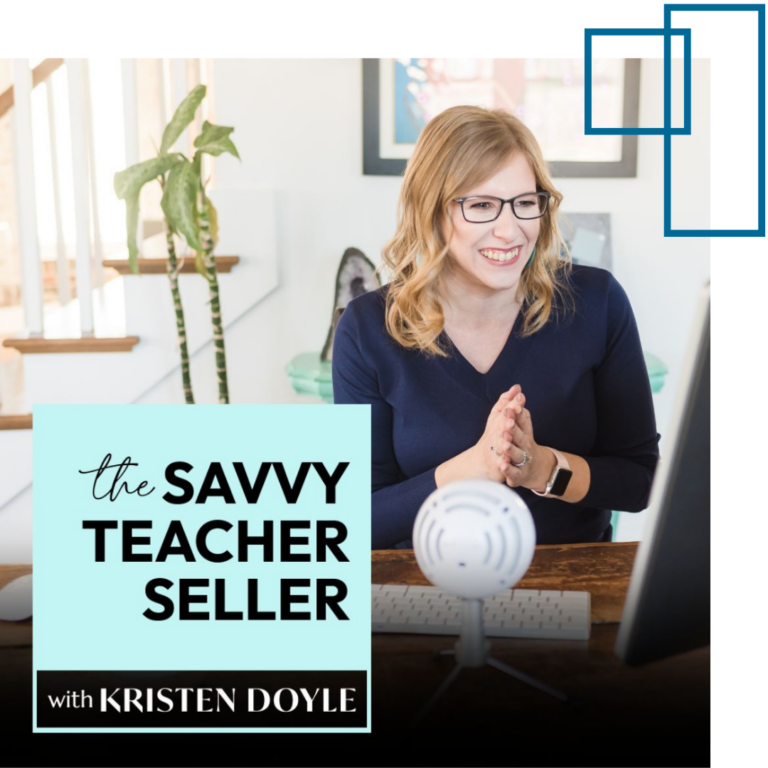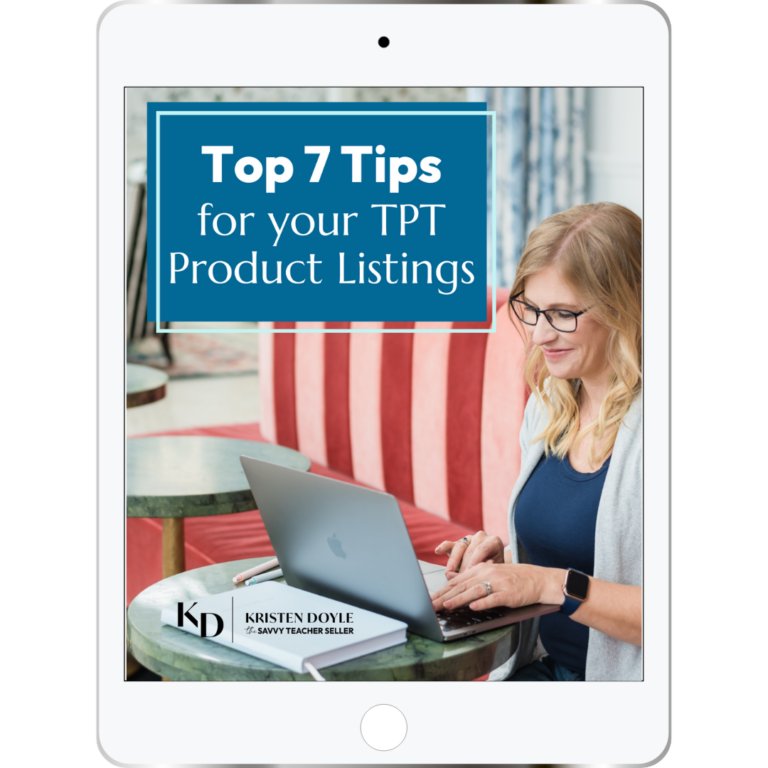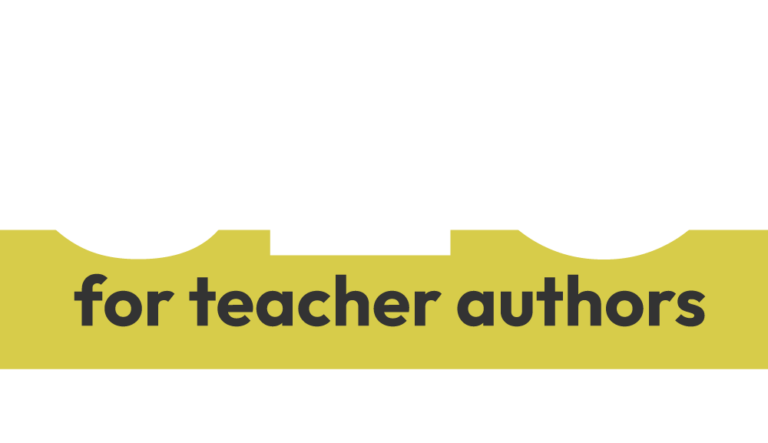Kristen
Hi, I am thrilled to have Jarrett Vaucher joining me today again for the second time, Jarrett and his wife Beth created your data playbook, which helps TPT sellers understand and use our data to drive strategy and results for growing our TPT stores. Jarrett is the business mind behind YDP as we call it, and he loves it using data as a strategic tool to help TPT sellers succeed.
Kristen
In today’s episode, we are talking about some specific ways that you can use your TPT data to drive your decision making and increase your sales. We’ll also be talking about why YDP is amazing new keyword research tool that I have been waiting on pins and needles for and how you can use it to really know which keywords you should be targeting for SEO in your products. Jarrett and I always have a ton to say once we get started, so let’s get right to it.
Kristen
Okay, TPT sellers ready to see growth in your business. You’re in the right place. Welcome to the savvy teacher seller. I’m Kristen Doyle. And I’m here to give you no fluff tools and strategies that will really make an impact on your sale. Let’s get started y’all.
Kristen
Hi, Jarrett, thank you so much for being here.
Jarrett
Hi, Kristin. It’s so great to be with you. I think this is my second time. I’m still as jittery as the first though. But I’m so excited to be here. Thanks.
Kristen
It is your second time you are my first repeat guest. So fine. I request when I asked people who they wanted to be a guest on the show one of the requests in addition to some new people was more Jarrett, please.
Jarrett
Wow, I feel humbled and honored. Thank you.
Kristen
So no pressure.
Jarrett
No pressure, you need to be amazing. Right? Thank you. But we gotta we got to think of excuse if it’s not amazing. What do we go with? I don’t know. You just got back from Italy. Right? It’s my fault, because I’m jet lagged right now.
Kristen
Well, I am super excited to dive into data with you a little bit more today. I know we’ve talked about data a lot in the past. And you know, and probably all of my listeners do, too, that data is something I’m pretty passionate about using to help grow my TPT business. So I know we have a lot of things on our list of topics that we were brainstorming.
Kristen
So let’s dive straight into some ways sellers can use their TPT data to really increase their sales. And one of my favorites is that using my data to help me figure out what price I should be using for all my different resources. So can we talk about that first?
Jarrett
Yeah, yeah, we can spend the whole the whole half I think we have about 20=30 minutes, right? Yeah. So we can spend, you can spend the time just going into that. I love the pricing conversation. I think pricing is as it is, is one of the biggest bang for your buck in terms of your time. So you get the biggest return on investment for pricing.
Kristen
Oh, yeah. And the time spent is so short compared to other things you can do. I mean, I can look at my data and adjust a price in a minute or less.
Jarrett
Yeah, that’s the beautiful thing, especially for people who are still in the classroom, or you know, they don’t have a team. So what’s one of the biggest, biggest actions that you can take in terms of optimizing your revenue or optimizing your earnings? Huge wins, if you’re willing to take a risk? I know, we could go into some mindset talk about like, Hey, how you think about pricing? Because a lot of people get scared about it, because it’s novel. Right.
Jarrett
But I think one of the biggest things to think about when changing price is really, it ultimately depends on demand. Right? I think so that’s the key thing is thinking about when to change of price. So if you have a product that has a really high conversion rate, like what like how do you look at your products? And how do you decide, for example, person, you look at a product that has a super high conversion rate, and then adjusted accordingly. And that’s one of the most common questions I have against like when to change the price. Is that where you find as well?
Kristen
That is one of the first places I look is conversion rate, to see how is it converting? Is it over performing conversion wise compared to the rest of my products?
Jarrett
I think that’s the key thing. So it depends on demand. And one of the strongest signals of demand is conversion, right? And that’s the beautiful thing we think about it, it’s like it’s the amount of people that see my product and purchase my product, and that’s a good signal. And so, when you think about another thing that I often hear is like, well, what’s a good conversion rate? You get that too. And again, it’s understandable, but the reality is that the conversion rate can vary by price level. So obviously lower priced items typically have a higher conversion rate than higher priced items. That’s just pure economics. Right?
Kristen
Yeah, absolutely.
Jarrett
Taking that into your consideration about like how you optimize for price one, one examples, like, how give that’s probably fresh on the mind is like, what’s a good conversion rate? Well, it depends on price, like I just said, so like, like a $3 product, right? So on average, when we look at YDP data, and like, it’s essentially 10% is a average conversion rate for a $3 product. So you’re above that, and let’s say the top performers that we see when we analyze all like the 300,000 products that we have, in the membership, what we see is like, the top performers are between 10 and 15%, and beyond.
Jarrett
So if you’re in that threshold of like 10, to 15%, or beyond, that’s a good indication that hey, that $3 product, you should start trying to change the price. So I think figuring out that threshold is okay, if $3 price is 10%. And then anything beyond 15 is like you’re crushing it, and you’re leaving money on the table.
Jarrett
One of my favorite examples of that was a someone who had a $3 product. And I encouraged was like, why don’t you it was like, I think your conversion rate was like 24%. And it’s like, hey, it was a seasonal product. Yeah, it was like Christmas, so if you change this price, let’s just test it. And so she ended up selling an extra 1000 units of that product during Christmas. And so she essentially made an extra $1,000, just for that $1 price. And that’s some quick money, right.
Jarrett
So that’s the value talking about going back to that initial outset, the comments like, you can drive a lot of value pretty quickly with understanding when to change those prices. And again, it’s going back to conversion. And just to give you like the other side of the spectrum, so like, give it $3 price point. And then like the high end that $200 and above, you’re talking a good average price, maybe like one and a half percent. And then like the top performers are above two, two and a half percent. So if you’re in that range of one and a half to two and a half at that $200 or above, like, then you honestly have room to squeeze more out of that product.
Kristen
Yeah, and at that higher price range, even a small increase percentage wise increase in your price could result in a pretty big increase in how much you’re actually earning.
Jarrett
Yeah, that’s true. I mean, I’ve seen some people are going a little aggressive, you know, like, like, Hey, it’s $200, and it’s a 4%, I’m gonna raise it to, let’s say, 250 300. So they’ll raise it 30% 40% on one.
Jarrett
So I think how I would recommend doing it like, I think it’s a natural next question is okay, like, if I want to raise my price, how much should I raise it by? And we generally recommend, like a good rule of thumb is five to 10%, right? When making pricing changes is like, it’s better to make small adjustments first, monitor the results and see how that impacts your earning and how your market responds to that change, right? Because every market can be different. And that depends on how competitive it is how unique your product is on demand. So I would just say, Don’t get stuck on like, oh, I don’t know how much to change it by but I think err on the side of being more conservative.
Kristen
Yeah,
Jarrett
That will help get and then you just get it out there to see how the market responds. And then if you see a response, well, I positively then you can go ahead and make another change. But I get nervous when people are like, Okay, I’m gonna raise it 100 bucks. I’m like, Oh, god and people had success. I just, I guess I’m more conservative are calculated Magaret. Again, so I get that if you’re going to take it. How in your experience? Have you been very aggressive? Are you more make small adjustments? Or how do you do it?
Kristen
I usually go around 10%, somewhere around there. Every now and then when you find that random product that you’ve been ignoring for the last little while and haven’t been looking at and you realize like, it gets a lot of traffic and my conversion rate is like 40%, then okay, I might jump in price up a good bit more. Because that’s an insanely high conversion rate. And I’ve had one or two of those, it’s usually a product that I just don’t think about very much.
Kristen
Yeah, it might not even be like a best seller, but it gets enough traffic that I can trust my conversion rate. And so if it’s that high, I should probably raise the price. And I find it so interesting that sometimes you raise the price, then you end up selling more of them. I think it’s a value perception thing.
Jarrett
Amen to that. Yeah, that’s a really good point. Value perception is huge. Because usually you think as you increase the price, you’re going to be each customer spends more, right? But you have less customers that are willing to pay that price. But sometimes like you’re saying it’s the value perception and it goes back to like the willingness to pay like and economics the concept is like willingness to pay is basically the maximum amount someone is willing to pay, but it’s actually your product looks more valuable to some people.
Jarrett
You’re always gonna have that segment of the market that’s willing to go go after the best product, like whether that’s a luxury purse or a luxury car, you can position yourself to be a luxury product in TPT, as well. So I do I find those cases very, very intriguing. And I’ve seen multiple, multiple times when it happened. And like, We just scratched my head.
Jarrett
So obviously, branding comes into that right and how you position your product? Because that I think that’s what you’re saying. And like, in terms of, like, how you position it covers, thumbnails, etc, like that? Is that how you and your experience? Is that what you see?
Kristen
Yeah, a lot of times, I think it’s it comes down to how good does your product look? Does it look worth that extra amount? One of my favorite things to tell people about pricing is prices are not permanent. Because I think as sellers, for some reason, we have in our mind that we set a price, and this is the price and it just is what it is.
Kristen
But prices are not permanent. So like you said, make a small change five to 10%, watch your data, come back, tweak it again, it doesn’t have to even stay at the price you changed it to. And on the flip side, you know, if you realize that you are if you’ve raised your price, and you’re selling you know, it’s totally normal, like you said to sell fewer, but you earn more because your price is higher. That’s a good outcome. Sell more, earn more is an even better outcome. But that’s not as common.
Kristen
But every now and then we do push too far on our product. And we realized that we’re selling less, but we’re also earning less at the higher price. And so the fix for that. I mean, I know that’s the fear that we all have, right is that I’ll earn less. The fix is easy. You go back in and you drop your price back.
Jarrett
Yep, totally. That’s well said I, I think we drink from the same water water cooler on that one.
Kristen
I personally, I tend to push it until I hit that point and then back up.
Jarrett
You hit it. Okay. Yeah, might have seen my conversion hit. And then you pull it back. Yeah. That’s a good way to approach it. The thing about mindset around pricing, what you just mentioned is, really, it’s like this, Jeff Bezos, he’s a ex CEO, now the chairman of Amazon, he says like, they’re in business, they’re AB decisions, right?
Jarrett
So a decisions, like you can walk through a door and shuts behind you. And you can’t revisit it right where the key decisions are, like revolving door at a hotel, and lkie in New York, you can go there, they’re always rotating and circling around. And so that’s the same way you need to think about pricing is that it’s not permanent, and you can revisit it, but I think it’s the fear of loss, right? Because we as humans are in our human psyche. We’re more conditioned to be risk aversed to lost and says, Hey, I already know I’m making this much and I’m okay with that. But when you think about flip it on its head and ask like, well, how much are you actually leaving on the table by not trying and raising prices? Right?
Kristen
Right.
Jarrett
So like, if that’s five grand in a year on one product, just because you sold Hey, imagine if you sold that volume? Let’s say you have a product that sells 5000 times a year and you raise it $1. Right. That’s five grand extra. So that’s the benefit.
Kristen
That is a vacation.
Jarrett
Yeah, that’s another Italy trip, right?
Kristen
Yeah.
Jarrett
Yeah, I think mindset shifts is like, again, that flexible, adjust your price, like you said, Yeah, being able to like, track it and identify, I think one of the biggest things that so that you can optimize. And having that data driven approach will help you to make sure that you’re delivering that value to customers, but also not selling yourself short.
Jarrett
I think, coming into TPT world and being an outsider but married to a teacher and learning more about working, loving working with you guys. I think one of the things that I’ve seen as a common pattern is that you guys tend to underprice your products. I think you undervalue you work. So I think that’s hard. But I think generally I see people under price more than they overpriced.
Kristen
Yeah, I do too. And there are exceptions, of course, I’m sure. But I feel like as a whole, we do tend to underprice. And maybe some of that is undervaluing our own work. I honestly feel like a little bit of that comes from just teacher mindset, because we’ve been conditioned for so long that our work is only worth this much. And it’s so much less than so many other professions, and of course wanting to serve our audiences who don’t make that much money.
Jarrett
Yeah, absolutely.
Kristen
So there’s that piece of it to be sensitive to as well. Yeah. So having that in the balance, I think is a good call out. So it’s like who you’re serving your customers, obviously, especially in moments right now where the economy’s a little bit battered. And then yeah, recessionary fears. So I think that’s huge. And then having your work as a professional maybe told that it wasn’t as valued as other professions, even though education is by far the bedrock of society like if without education, like
Kristen
There’s nothing else.
Jarrett
Yeah, I hear that, just I think so try to figure out what’s a good, happy place and a good medium for you to balance those those three things. Because, yeah, you also you want about your work, but at the same time you want us to, and create value for your customers, but at the same time, not to your own detriment for undervaluing work. So, yeah, those are three good bit.
Kristen
And I think it all comes back to using your data and looking at it on a regular basis. So that as you adjust your data will tell you when you go too far. Yeah, it will absolutely tell you when you have out priced your market.
Jarrett
Yeah, absolutely. And think that we’re looking more into with that, as we’re learning more about the data and the market is being willing to change. And again, this is this probably unconventional idea what I’m about to say, but like actually having seasonal prices, okay, I’m an airline guy come back from so like, you’re all it’s all about, like seasonal pricing and the price optimisation. So yeah, that’s very much my paradigm when I’m when I’m talking about this.
Jarrett
But like, I know, there are seasons around the year where there’s higher conversion rates, because demand is higher, like back to school, for example. So like, we’ve tested having a, like low season prices versus high season prices for the same product to see how that particularly, and it’s worked well. But just understanding because there’s different points in the demand is higher. So how do you capture on that? Again, that’s a very airline business optimization standpoint, and the data will tell you that as well.
Kristen
Yeah, and our stuff is very seasonal, too. So I can see that working. That’s something I have not played with, but I’m really intrigued, and I’m gonna have to try it now. As you were talking, I had specific products rolling through my mind. So I’m gonna have to give that a try this, especially like this spring leading into summer, getting ready for back to school season.
Jarrett
Absolutely. Test it with a couple I’d love to hear what happens and give me your feedback on that.
Kristen
I will for sure. Well, let’s shift gears just a little bit for pricing. I know we could probably keep talking about pricing for another hour. Yes. Let’s shift gears a little bit. One other thing I love to do with my data is use it. And this is probably the thing I do most to figure out which products need updates. And for me, that kind of goes two ends of the spectrum, I have top sellers that really shouldn’t be selling even more than they currently are. If I tweaked some things, and I know, it’s kind of goes back to that mindset of being okay with how much I’m currently selling and being afraid of the risk of changing things.
Kristen
But in my experience, most of the time when I change things that sells more, because I’m using my data, and I’m making the right changes. And on the flip side, just like pricing, you can always switch it back. If I change my cover and thumbnails and I’m suddenly selling less well, I’ve got the old ones. Right. We are all digital hoarders who don’t delete anything. So you pull the old ones back out, and you put them back?
Jarrett
Well said. Yeah, it’s true. I mean, I think that one of the biggest things that we saw is the impact of a preview. Right, I think, I think this is last time. But it’s like the products that don’t even have a preview versus the products that do they convert on average 30% better. So how much obviously your best sellers, if they don’t have a preview, like that’s like, less top order business, right?
Kristen
Put a preview on it.
Jarrett
I’m sure at this point you do though. So yeah, top sellers, you want them to some more. And again, if you think about the role of product optimization and product listing, it’s like how do you take people from the search result and get them to purchase and think about the different path or the customer journey to get them there? Right?
Jarrett
So like, how do you optimize that journeys? Like, okay, the cover, I need to make sure that stands out, but I stopped the scroll, and I get the click through rate, right. And so hey, if you’re looking at the ratio of people that are seeing your product, and actually clicking, we can have some perfect data set from TPT. I would love some more data on impressions, and etc. Like, yeah, you know what i’m talking about?
Kristen
Yes, we can all dream.
Jarrett
Yeah, but like so thinking about like, okay, how can I make the cover better. And if I know people that are clicking on my cover, and then actually going to my preview, the whole thing is, I need to get people to look at my cover, thumbnail and use your thumbnails as this bridge to get them to that preview. And if you get them to that preview, the probability of conversion goes up dramatically.
Jarrett
So stop the scroll with a pop up a search, get them to click on your cover, and then give them that that micro conversion. So think about those micro conversion. The first type of conversion is you want them to click on your cover. The second micro conversion is you want them to click on your thumbnail so they get more information to go check out your preview. And then once you have a well crafted persuasive preview, the probability of like I said, it just goes up dramatically.
Jarrett
So thinking about that, probably finished my preview, I just jumped in the probability of conversion goes up dramatically. That’s the exciting part and understanding that value. So if you see like a top performer where you have a ton of traffic, but you know, and I get in in YDP, we talk about the concept of like, preview to purchaser. And so how many people are actually looking at my preview and purchasing and then that ratio and so if you have a low ratio of people that are actually doing that.
Jarrett
So that’s the middle of the funnel, right? That’s the consideration phase. If you have that, you can say, Hey, how can I increase the middle of the funnel, my preview to purchase rate or that ratio. So if I have one in 10, people that are clicking on my preview, then purchasing, can I make double that to five and 10. And that ultimately will drive conversion up substantially. If you can think about just that one component of a preview. I mean, we can talk about this so many other aspects, but just thinking about that from a best seller standpoint.
Jarrett
But again, if you’re not even getting them to that preview, obviously, you have more work to do on your title, for example, or your cover because you want them. But in this case, it doesn’t sound like that, right? Because you have a product that’s selling really well. And now you just you just want to convert in some more. So it’s not a traffic issue. Right?
Kristen
Yeah. So then it’s, I mean, maybe it could be a traffic issue, I guess. It’s selling really well. But could it get more traffic? Could my preview convert better? I mean that’s really, is for looking at that data comes into play, where you have to see what the numbers are saying, Am I getting tons of traffic, but my preview rate is low, or my preview to purchase ratio is low? In which case, what can I do to increase those things? If those are high, but I’m not getting as much traffic as maybe I should, then how can I get more people to this product listing? Is it SEO? Is it marketing? Is it you know, what, what can I do?
Jarrett
If it’s a traffic issue? You really have a couple options, right? It’s like, okay, SEO obviously is organic, it’s cheap. And it’s you know, it’s one of those things that is evergreen, you don’t have to work hard for it, you have to work hard to get on those top results. Right. But once you’re there, it’s ongoing. So you can either do the organic side, or you can do the paid side, the paid side obviously, it’s like a sugar rush, you can get traffic fast. But it’s not sustainable. Right? Because you always require.
Jarrett
So yeah, I think the traffic one, in the end seems like in light of everything that’s going on with with personalized search. And now that rolling back, we’ll see how it all pans out. But I know like for us this last year, we’re up about 30%. And our pages are up about 40%. But we’ve never spent as much money on paid advertising.
Kristen
It’s taking a lot more to get there right now.
Jarrett
Yeah, it’s taking a lot more it’s moving a heavy truck. So again, that’s why they cannot overemphasize the importance of SEO like, that’s the best long term strategy. But if you need to get eyes on a product fast, obviously SEO is harder to get traction. If it’s a super concentrated or a competitive market.
Kristen
Yeah, yeah, absolutely. I think it’s so important to balance those two. For me, SEO is like the non negotiable, we’ve got to do that part. Because we need organic traffic, we need to get people there that I don’t have to pay for but sometimes when it is in season, or when there’s a lot of competition or whatever, then taking a little trip to the traffic store, aka ads is exactly what we need.
Jarrett
I love that. I love that saying take a trip to the terror. That’s great. I love it. And then you have the perpetual email list, right? I think those are the biggest thing. That’s an asset you own. So regardless of algorithm changes, that’s super valuable for any for any business, any size.
Jarrett
Top Sellers, always try to push like if especially seasonally, you want to you want to make sure you’re you’re hitting up your email list, and then revising your SEO strategy. I mean, I’m looking at like relevant terms that are trending. I think it’s also big, right? So if you see a shift in the terms that like the last few days, last 60 days, you’re looking at what words yesterday are showing up? That’s a good way to say hey, like, Can I upgrade?
Jarrett
You know, Neil Patel, is he but I was listening to a recent podcast or webinar with and he said, like, how are these AI going to change SEO? So it’s talking about that, but then it’s like, the biggest thing is just like, again, it’s not it’s nothing new under the sign. It’s just relevancy. So how can we understand what is relevant right now and make sure that our best sellers are continuing to target the most relevant terms and it’ll help accelerate that and help do that. Some of that learning for us.
Jarrett
So, but yeah, I think he’s relevancy and understanding what’s trending and being willing, again, to get out of the comfort zone and say, Hey, this keyword is always worked for me. Am I willing to try and test a keyword title change for this particular season? Without that, again, you and I know like that talking about keyword stuffing?
Kristen
Absolutely not. We’re not talking about being shady and putting keywords on don’t apply any of those things. But looking at Yeah, have the keywords for what I have created the good solid keywords for this have they shifted? Is the way that teachers are talking about this type of product changing? Because we all know that in education, trends come and go and half the time when the new trend comes. It’s the same as the old trend. It just has a new name, what we need to adjust and adapt to that.
Kristen
Speaking of which, by the time this episode airs YDP will be open for enrollment. And there are some pretty exciting new things you have going on. I want to talk about those. And one of them is the keyword research tool. Can you talk a little bit about how we can use that?
Jarrett
Yeah, so that tool is relatively new. And it’s honestly about identifying what terms are showing up in the keyword suggestion box. So when you type in a keyword on TPT, you see the different suggestions, right, and all the hope the purpose of that is basically to help buyers match to buyers at the demand side to help with the supply. So say, hey, buyer, you’re typing in this. And this is the supply that I have to help make the market right.
Jarrett
So search is all about connecting supply and demand, right, you need to keyword stuff connected. So what we’ve done is just created a tool to help track suggestions over time, and tell you which ones are most popular by the amount of times that they show up. And at any given period of time.
Kristen
Which is so helpful, because the big downfall with looking at those search terms is they change day to day. And from looking at them, you can’t tell if something is just popular today. Or if it is always popular unless you’re gonna go in and do all that yourself, which no one has time for. So I know I am personally very glad that you figured out how to do this.
Jarrett
Yeah, I mean, I thought of you specifically.
Kristen
We’ve been talking about this for a long time.
Jarrett
Yeah. So it’s something that yeah, I’m excited to partner with you on and continue to flesh it out. So the four really main uses is essentially is updating, like we just talked about updating your products with most relevant keywords. So you actually can see how those keywords are trending over time to see okay, what is most popular? And hey, is this just a fad for a day? Or is this actually just have staying power just here for the last 30 days? Last 60 days? Hey, is it actually here the last year? Okay, yeah, I probably should update this term. So that is updating, especially on products that like, again, top sellers, hey, I need to update them and also those that have fallen off, right? You’ve seen them, their bleeding, maybe like, hey, how do I recover some of those pageviews.
Jarrett
So that’s a good way to upgrade and make those terms more relevant in your titles and descriptions. And then another one is for new product creation, maybe there’s a term that you can track, you can see different terms that show up that you’ve never even thought of before. And so that helps with product creation. So Oh, I really if people are searching for that.
Kristen
A lot of times, I’ll see a term show up in my keyword tool. That is that the right term for the product I’m searching for, but it’s close enough related that it shows up under you know, the same maybe root word. And a lot of times that triggers a really great new product idea. And the nice thing about that is it’s a new product idea right in line with the things you already sell.
Kristen
So your audience is probably ready to buy those sorts of things. It’s a perfect way to branch out and come up with some new ideas for what else you can be creating.
Jarrett
Yeah, absolutely. So it’s like, it’s either I think that’s the third use case is like you have new product creation, like I have a gap. And there’s a market here and I didn’t realize it, or it’s like repositioning existing products, and to adjust to that. So again, that’s kind of related to number one, but and then the last case is like really content planning, like understanding what’s popular buy time and year and then be able to plan for like, Hey, how are you going to launch products or how you’re going to market products or, you know, types of to your traffic systems like blogging, emailing, and just like planning back to school, like so it’s just super helpful to have a visibility to understand what’s trending by month, and then what keywords are unique for that particular month. So that’s, that’s the four use cases, and that’s where it’s at right now. And there’s more ideas and feedback coming in the pipe. But yeah, that’s where it’s at right now.
Kristen
I love it, I am so excited. It’s out for everybody now. And that it’s made its way out of beta, because I love to having it. It’s so exciting that it’s out for everybody now too, and just gives us so much more information that we can use, and so much more valid than just looking at what shows up in those dropdowns.
Kristen
It definitely has helped me decide between a couple of keywords that you know, I see a couple that come up in the dropdowns when I’m searching, but I can use my data there to be able to tell like really, which one is more popular.
Jarrett
Yeah, absolutely. And then I’d love to go through and look at like the lifetime, basically how long has this been? And then you have the rank and without getting into too much detail. But yes, that’s super helpful because that’s the question as the problems that pick which one is more popular if you have both that are competing. It helps with that. But it’s again, it’s great, but there is no like, perfect solution in our environment unfortunately.
Kristen
No there’s not I don’t think we will ever have anything like Uber Suggest or anything that can give us a true difficulty score and amount of volume and all of that, but if TPT is listened they could maybe help us.
Jarrett
Yes, please it’ll be worth it. Right. But this is still it’s such a good step in in terms of having some good data about keywords and which ones we should be. I am obviously super excited about that one, because SEO is my thing. And I love talking to people about how they can use the keyword tool. Now that it’s out for everybody. We’ve been talking about that some in my coaching program. And they are they’re loving it, too.
Jarrett
I’m excited to work with you on that and figure out how we can make it better and what you guys need to tailor it to your clients. And yeah, just yeah, we are. We want to empower you guys and make your jobs easier and obviously more successful and it’s fun. We get excited and motivated by seeing other people have success.
Kristen
Yeah, absolutely.
Jarrett
Yeah, that’s really what is the driving force. So it’s fun to see that. Okay, this is working, and people are finding value from it. Excited for next steps.
Kristen
I am too excited to get in and do some stuff with you guys.
Kristen
Well, thank you again, so much for being here for a second time on the podcast. I always love to talk data with you, as you know, so always fun to have these conversations. And I know everyone appreciates all of your valuable insights and everything that you do for the TPT community.
Jarrett
Well it’s good being here, Kristen, I love talking with you as well. It’s always fun. Lots of laughter, I gotta keep drinking some liquids because my throat is parched. We always run out of time. Right? I think we can we can do like two hour podcast marathon. So yeah, grateful to be here. Thanks. And it’s fun working in talking with you and sharing insights and knowledge and serving the community with some things.
Kristen
Thank you. Thanks for listening to today’s episode. I hope you found our discussion with Dara insightful and gained some valuable tips on how you can use data to drive your TPT stores success. Don’t forget to check out Your Data Playbook at Kristendoyle.co/YDP. To learn more about how YDP can help you use your data to drive your TPT sales. Plus take advantage of their brand new keyword research tool to make the most of your TPT SEO strategy. Thanks again for tuning in. I’ll talk to you soon.
Kristen
I hope you enjoyed today’s episode. If you did, please share it with another teacher seller who would also find it helpful. For more resources on Growing Your TPT business. Head to Kristendoyle.co/TPT. Talk to you soon.



